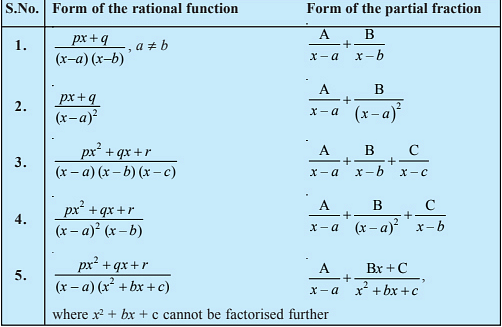Integrate the rational function: \(\frac {cos \ x}{(1-sin\ x)(2-sin\ x)}\)
Show Hint
Put sin x = t
Solution and Explanation
\(\frac {cos \ x}{(1-sin\ x)(2-sin\ x)}\)
\(Let \ sin \ x = t ⇒ cos \ x\ dx = dt\)
∴ \(∫\)\(\frac {cos \ x}{(1-sin\ x)(2-sin\ x)}\ dx\)= \(∫\frac {dt}{(1-t)(2-t)}\)
\(Let\) \(\frac {1}{(1-t)(2-t)}\) = \(\frac {A}{(1-t)}+\frac {B}{(2-t)}\)
\(1 = A(2-t)+B(1-t) \) \( ...(1)\)
\(Substituting\ t = 2 \ and \ then\ t = 1 \ in \ equation \ (1), we\ obtain\)
\(A = 1\ and\ B = −1\)
∴ \(\frac {1}{(1-t)(2-t)}\) = \(\frac {1}{(1-t)}-\frac {1}{(2-t)}\)
⇒ \(∫\)\(\frac {cos \ x}{(1-sin\ x)(2-sin\ x)}\ dx\) = \(∫\)\([\frac {1}{(1-t)}-\frac {1}{(2-t)}]\ dt\)
= \(-log\ |1-t|+log\ |2-t|+C\)
= \(log\ |\frac {2-t}{1-t}|+C\)
= \(log\ |\frac {2-sin\ x}{1-sin\ x}|+C\)
Top Questions on integral
Let \( f : (0, \infty) \to \mathbb{R} \) be a twice differentiable function. If for some \( a \neq 0 \), } \[ \int_0^a f(x) \, dx = f(a), \quad f(1) = 1, \quad f(16) = \frac{1}{8}, \quad \text{then } 16 - f^{-1}\left( \frac{1}{16} \right) \text{ is equal to:}\]
- Let $ f(x) $ be a positive function and $I_1 = \int_{-\frac{1}{2}}^1 2x \, f\left(2x(1-2x)\right) dx$ and $I_2 = \int_{-1}^2 f\left(x(1-x)\right) dx.$ Then the value of $\frac{I_2}{I_1}$ is equal to ____
- The value of the definite integral \( \int_0^{\pi} \sin^2 x \, dx \) is:
- Evaluate the integral: \[ \int \frac{\sin(2x)}{\sin(x)} \, dx \]
- Find the value of the integral: \[ \int_0^\pi \sin^2(x) \, dx. \]
Questions Asked in CBSE CLASS XII exam
- Nita, Vidur and Mita were partners in a firm sharing profits and losses in the ratio of 3 : 4 : 1. On 1st April 2024, they decided to admit Samir as a new partner. The new profit sharing ratio between Nita, Vidur, Mita and Samir will now be 1 : 1 : 1 : 1. The balance sheet of Nita, Vidur and Mita before Samir’s admission showed machinery at ₹ 6,00,000. On the date of admission, it was found that the machinery is overvalued by 20%. The value of machinery shown in the new Balance Sheet after Samir’s admission will be :
- CBSE CLASS XII - 2025
- Admission of a Partner
- Altima Ltd. invited applications for 2,00,000 equity shares of ₹ 10 at a premium of ₹ 4 per share. Amount payable:
On application and allotment – ₹ 7 (incl. ₹ 1 premium)
On first and final call – Balance.
Applications received for 2,40,000 shares. 30,000 rejected. Manvi allotted 4,000 shares failed to pay first and final call. Her shares were forfeited. These were reissued at ₹ 4 per share fully paid-up.
Pass journal entries in the books of Altima Ltd.- CBSE CLASS XII - 2025
- Accounting for Share Capital
- If \( \vec{\alpha} = \hat{i} - 4 \hat{j} + 9 \hat{k} \) and \( \vec{\beta} = 2\hat{i} - \hat{j} + \lambda \hat{k} \) are two mutually parallel vectors, then \( \lambda \) is equal to:
"There is widely spatial variation in different sectors of work participation in India." Evaluate the statement with suitable examples.
- CBSE CLASS XII - 2025
- Population
Alexia Limited invited applications for issuing 1,00,000 equity shares of ₹ 10 each at premium of ₹ 10 per share.
The amount was payable as follows:- On application ₹ 9 per share (Including premium ₹ 6 per share)
- On allotment ₹ 8 per share (Including premium ₹ 4 per share)
- On first and final call ₹ 3 per share.
Applications were received for 1,50,000 equity shares and allotment was made to the applicants as follows:
Category A: Applicants for 90,000 shares were allotted 70,000 shares.
Category B: Applicants for 60,000 shares were allotted 30,000 shares.
Excess money received on application was adjusted towards allotment and first and final call.
Shekhar, who had applied for 1200 shares failed to pay the first and final call. Shekhar belonged to category B.
Pass necessary journal entries for the above transactions in the books of Alexia Limited. Open calls in arrears and calls in advance account, wherever necessary.
Concepts Used:
Integration by Partial Fractions
The number of formulas used to decompose the given improper rational functions is given below. By using the given expressions, we can quickly write the integrand as a sum of proper rational functions.

For examples,
